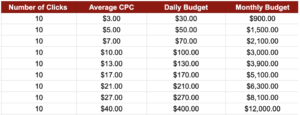PPC campaigns grant you control over who can see your ad copy, making sure you only invest in customers who are most likely to convert. PPC campaigns nowadays use incredibly complex methods to serve your ads to users. Often, a minor change entry such as changing from targeting CPA to targeting ROAS, can make a huge difference between profits and losses. But why does this happen? After reading this blog, you will be prepared to make your PPC campaigns profitable and avoid making very expensive mistakes.
Let’s explore the following rules:
- Accrue enough data.
- Budget for success.
- Narrow Targeting.
- Understand trends.
Ad Delivery & AI
PPC platforms such as Google, Microsoft, or Facebook rely heavily on AI to deliver ads. This means that, in order to make PPC campaigns profitable, we must understand how AI works at a deeper level.
AI uses predictive analytics to identify users and deliver ads, which works better when it has lots of data to work from. The more data AI has, the better. So, the success of our campaigns rely on how much information we accrue each day. In this context, data sets have a minimum threshold required to help AI make informed decisions. Anything below that threshold would likely turn profits into losses.
For instance, if you are tracking enough data per day, your PPC campaigns (and the AI behind them) will have the following:
- Improved Accuracy: PPC campaigns or website analytics like GA4 use predictive statistics to understand, identify and predict user behavior.
- Better Generalization: With more data, your PPC campaigns can generalize from old to new data efficiently – this helps to find similar converters, for instance.
- Forecasts & Increased Precision: Predictions are more precise. This is super helpful at identifying users without cookies i.e. if I’m on my laptop searching for pizzas and then switch over to my phone without login in, a successful statistical model would determine I’m the same user.
- Better Decision Making: Accurate and reliable predictions yield increased efficiency. which turns into better allocation of resources and profits.
“Enough data”. What does that even mean? How much data is enough data? To figure it out, let’s discuss budgeting.
Budget: How low can you go?
Let’s talk about Google Ads in this example.
The cost of Google Ads would vary depending on several factors such as geography, competition, keywords or targeting methods, ad types or networks, among other things. The same is the case for any other PPC or advertising platform. Metrics would vary greatly from one industry to another.
In order to figure out the lowest threshold of data we should accrue per day, we will use the metric “Clicks”, a data set value which can be measured uniformly across industries regardless of competition or CPCs.
My recommendation here is to accrue at least 10 clicks per day. If the average CPC is $5, then you need a budget of at least $50/day. Here is a table summarizing how this may look with different CPCs.
Every click or related metrics we gather matters a lot. The success of your PPC campaigns depend on predictions established by this data. If you accrue data from the wrong audience, Google Ads will learn to get more of those. It creates a chain reaction towards failure. (Ouch)
Targeting – Narrow to Beyond
Now that we have the right budget in place, let’s make sure we use this money wisely. Ideally, we want to start with a tailored, narrowed reach, and then work our way broader if we need more traffic volume.
At first, this may appear to contradict our first rule – to get enough data per day. However, we can filter our audience as much as we want. We just have to make sure it accrues at least 10 clicks per day or more. Also, a narrow strategy doesn’t necessarily mean low search volume, it simply means strict targeting rules. You can have strict targeting rules with lots of search volume.
The reasons why you need a narrow audience or strict targeting rules are the following:
- Cost effectiveness: If your audience is not working out or if the traffic volume is too low, you can always just expand your reach by updating your targeting methods. This requires less budget than doing the exact opposite – starting broad and then narrowing down.
- If you talk to Google representatives directly, they will recommend doing a broad strategy at first because their narrative is to “accrue as much data as possible for their system to learn faster”. But, oftentimes, it’s too expensive. It is possible to do a narrow reach strategy and still get enough data for the system to learn fast and efficiently.
- Better quality scores: A narrow audience can help you stand out from competitors easier. This means lower CPCs and higher ad rank.
- Repeat rate: Users might not convert on their first interaction with your ad copy. A narrow audience makes it possible to show your ad multiple times to the same user. The conversion path is very complex and requires multiple interactions according to Google – “Decoding Decisions: The Messy Middle of Purchase Behaviour”. If you are showing your ad copy to users only once in their purchasing journey, you are missing out.
How can you target a narrow audience with your PPC campaigns? That depends on the advertising platform you are using. Additionally, the type of campaign, network, and objectives all play a role in nailing down your targeting.
In future posts we will explore examples on how to set up a narrow audience on Google Ads and LinkedIn Ads. Also, we will explore the last rule for “Understanding trends”.





